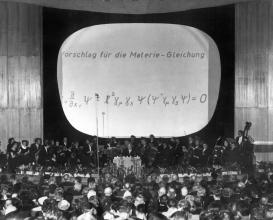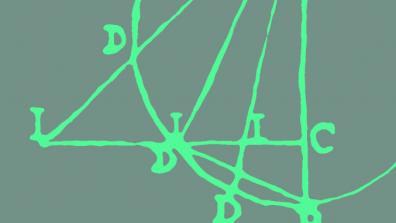Date & Location
November 28–29, 2019
"History for Physics: Quantum Gravity" was hosted by the Max Planck Institute for Gravitational Physics (Albert Einstein Institute), Am Mühlenberg 1, Potsdam-Golm.
Watch Online
Schedule
-
Day 1
Day 1 - 09:00 Registration
- 09:30 Welcome
- 09:45 Why History for Physics?
Invited Tandem 1
- 10:00 Hermann Nicolai (Physics)
11:00 Coffee Break
- 11:30 Alexander Blum (History)
- 12:30 Discussion
13:30 Lunch
Panel Discussion
- 14:30 Arianna Borelli
- 14:50 Roberto Lalli
- 15:10 Discussion
17:00 Refreshment and start of the social evening program
-
Day 2
Day 2 - 09:30 Recap Day 1/Welcome Day 2
Invited Tandem 2
- 09:45 Claus Kiefer (Physics)
10:45 Coffee Break
- 11:15 Thiago Hartz (History)
- 12:15 Discussion
13:00 Lunch
Contributed Talks
- 14:00 J. Brian Pitts
- 14:40 Pablo Ruiz de Olano
15:20 Break
- 15:40 Alessio Rocci
- 16:20 Juliusz Doboszewski
17:00 Final remarks and plenary discussion
18:15 Dinner (for speakers and organizers only)
19:15 Roundtable regarding the future development of "History for Physics"
20:15 End
Invited Tandem 1
-
Hermann Nicolai (AEI): Quantum Gravity—Puzzles and Perspectives
Current efforts towards the construction of a theory of quantum gravity reconciling general relativity and quantum mechanics are at crossroads: in spite of a huge collective intellectual effort over more than 40 years it looks like we may still be far from a final answer. In this talk I will give an overview of different approaches to the problem, and discuss their respective merits, problems and future perspectives.
-
Alexander Blum (MPIWG): Why Are There So Many Theories of Quantum Gravity?
Following up on Hermann Nicolai’s overview of the various approaches to quantum gravity and their current status, I present an inquiry into the historical origins of this diversity. Rather than focusing on specific programs, I investigate three main historical processes of division: The emergence of different formalisms for constructing a quantum theory (quantization procedures), the different attitudes toward the role of quantum gravity within physics (final theory or mere consistency check), and the emergence of different specialized communities within the discipline of physics in the course of the twentieth century (in particular the establishment of the high-energy and general relativity/gravitation communities in the 1950’s). I conclude with some reflections on how an understanding of the origins of these divisions and the original arguments can help physicists in assessing the current status of quantum gravity.
Invited Tandem 2
-
Claus Kiefer (University of Cologne): Unitarity in Quantum Gravity
Unitarity is an important property for the quantum states of a closed system, because it guarantees the conservation of probability. In my talk, I discuss unitarity in quantum gravity, where there is no longer an external spacetime. My discussion is divided into two parts. In the first part, I discuss the necessity to introduce fictitious ghost fields in the path-integral formulation of quantum gravity, which is also relevant for other theories such as Yang-Mills theories. In the second part, I address the fate of unitarity in quantum geometrodynamics, which is the non-perturbative canonical approach to quantum gravity in metric variables. This fate of unitarity is directly connected with the concept of time at the most fundamental level.
-
Thiago Hartz (Federal University of Rio de Janeiro): Unitarity, Ghosts, & the Role of Mathematics in the History of Quantum Gravity from 1950 to 1967
In the late 1940s, when renormalization methods were successfully applied in quantum electrodynamics, the community of quantum field theorists split into two groups. One group wanted to find a more solid ground for the theory, while the other group began to apply those new methods to other interactions, e.g., the nuclear and the gravitational ones. The latter group expected that these interactions could be handled with similar methods, however in the 1950s and 1960s such an expectation was frustrated. The gravitational field was particularly problematic, since it led to a non-unitary S-matrix, as Richard Feynman discovered in 1962.
In this talk I will present a history of some quantum theories of the gravitational field from 1950 to 1967, emphasizing in particular the works of Richard Feynman, Bryce DeWitt, Ludwig Faddeev, and Victor Popov. I will explain their research projects and their main results—in particular the discovery, due to these four physicists, that, in order to restore the S-matrix unitarity, one must incorporate in the theory a new field, which is nowadays known as the Faddeev-Popov ghost. I will conclude with an epistemological reflection about the strategies for theory selection and about the role of mathematics in quantum gravity.
Contributed Talks
-
J. Brian Pitts (University of Cambridge): Peter Bergmann on Observables in Hamiltonian General Relativity
The problem of observables and their supposed lack of change has been significant in Hamiltonian quantum gravity from the 1950s till now. This talk considers the unrecognized variety of ideas about observables in the thought of constrained Hamiltonian dynamics co-founder Peter G. Bergmann, who also trained many students at Syracuse University, New York. Whereas initially Bergmann required a constrained Hamiltonian formalism to be mathematically equivalent to the Lagrangian formalism, in 1953 Bergmann and Schiller introduced a novel postulate, motivated by facilitating quantum gravity. This postulate held that observables were invariant under transformations generated by each individual first-class constraint. While modern works rely on Bergmann’s authority, he had much to say about observables (e.g., 1953, 1956, 1956, 1957, 1961, 1962, 1962), not all mutually consistent and much of it rarely read.
On occasion he required observables to be locally defined (contrary to the inference that Bergmann's observables are changeless and global); at times he wanted observables to be independent of the Hamiltonian formalism (contrary to the definition involving separate first-class constraints). Hence there is no concept of “Bergmann observables” (pace the physics literature) which he reliably endorsed. A revised definition of observables that is coherent, is physically reasonable, and satisfies the requirement that equivalent theories should have equivalent formalisms can be devised with help from Bergmann (assisted by insights from others). It implies that observables vary locally and are independent of the Hamiltonian formalism, as Bergmann sometimes wanted.
-
Pablo Ruiz de Olano (MPIWG): Approximation Methods during the Early History of High-Energy Physics: The Cases of the Chew & Nambu-Jona-Lasinio Models
In this presentation, I use the development of the Chew and the Nambu-Jona-Lasinio models during the 1950s and 1960s as case-studies to illustrate the increasingly important role that approximation methods came to play in high-energy physics after WWII. After that, I go on to add some reflections on the kind of conceptual structures that are best suited to analyze the practice of high-energy physics during this period. The presentation is based on collaborative work carried out in the context of the Max Planck Research Group “Historical Epistemology of the Final Theory Program" together with Alexander Blum, James Fraser, and Rocco Gaudenzi.
-
Alessio Rocci (University of Padova): Working Outside the Mainstream: A Pilot-Wave-Like Approach to Semiclassical Quantum Gravity
The so-called Copenhagen interpretation provided a pragmatic, even if controversial, description of the ontological status of the wave function and of the role of Born's rule in quantum mechanics. In contrast the so-called de Broglie-Bohm interpretation, which lies at the foundation of the modern pilot-wave theory, offers a very different, and sometimes claimed more convincing, picture of reality. There is no doubt, from a historical point of view, that pilot-wave theory had a severe stop in 1927, i.e. after that the fifth Solvay conference took place in October. As a consequence, it gained the status of viable alternative only after the Fifties and it seems that its possible application to unsolved problems of Physics, like e.g. the search for quantum gravity, has emerged only recently. As we have already suggested in a previous paper, a recent historical analysis of the fifth Solvay conference showed how the first attempt to unify general relativity and wave mechanics, published by Léon Rosenfeld soon before the Solvay conference, was considered by Louis de Broglie as a possible implementation of his ideas. This paper aims to reconsider the work of Rosenfeld from this perspective and to clarify the role played by Theophile De Donder in the formulation of Rosenfeld's attempt. We argue that, in his earliest papers, Rosenfeld presented a pilot-wave approach to the problem of semiclassical quantum gravity. He considered the quantum behaviour of a many-particle system in a given gravitational and electromagnetic field and discussed both the role that could play gravity in de Broglie’s picture and the emergence of deterministic statistical interpretation, which agreed with Born’s rule. This was the highest point reached by pilot-wave theory before his stop between the end of Twenties and Bohm's revival.
-
Juliusz Doboszewski (University of Bonn): Black to White Hole Bounces: An Integrated History and Philosophy of Science Perspective
Black to white hole bounces are a class of quantum gravitational scenarios describing late stages of the lifetime of an evaporating black hole, under which presence of repulsive quantum effects leads to tunneling of the black geometry into a time-reversed solution (a white hole). Such bounces provide a form of singularity resolution as well as an answer to the information loss paradox. However, both the remnant proposals and white hole spacetimes are plagued by instabilities. It turns out that there are two distinct arguments for the white hole instability: an early argument based on infinite blueshift, and (arguably more compelling) an argument based on accretion. Some recent claims concerning the stability of white hole remnants address the infinite blueshift argument, but not the accretion argument. Attention to this detail implies corrections to the bounce scenario; I will illustrate this claim using an evaporating black hole embedded in a cosmological model with accelerating expansion.
Panel
The panel discussion is intended to be an interactive introduction to the history of physics as a discipline. We therefore kick off the panel with impulse talks and then open the discussion, where an active participation of the audience is encouraged.
- Pablo Ruiz de Olano (MPIWG)—Moderator
- Alexander Blum (MPIWG and AEI)
- Arianna Borrelli (Leuphana University Lüneburg)
- "What Do Historians of Physics Do—and Why Should Physicists Care about It?"
- Roberto Lalli (MPIWG)
- "The History of Modern Physics in the Academic Landscape"
- Dieter Hoffmann (MPIWG)
- "Remarks about the situation of History of Physics in Germany"
Getting to the Event
-
 Map & Directions
Map & DirectionsGolm is a district of Potsdam, Germany located on the outskirts of the city. Potsdam is the capital of the State of Brandenburg and is located south west of Berlin. The AEI is part of the Max Planck Campus in the Science Park Potsdam-Golm.
From Berlin
The regional train RB21 (direction Griebnitzsee) runs every 30 minutes from Berlin Ostbahnhof via Friedrichstraße, Alexanderplatz, Hauptbahnhof and Zoologischer Garten to the station Bahnhof Golm (travel time approx. 40 minutes). It is a 10 minute walk from the station to the Max Planck Institute or one stop by bus no. 605 or 606.
From Potsdam
From the central station take bus no. 605 or 606 to the Science Park Golm (travel time approx. 30 minutes). The regional trains RB22 (direction Berlin-Schönefeld Airport) and RB21 (direction Berlin Hauptbahnhof) also stop at Golm (travel time approx. 10 minutes).
From Berlin-Schönefeld Airport (SXF)
The regional train RB22 (direction Griebnitzsee) runs every hour between the airport and Golm (travel time approx. 30 minutes).
Direction from the Airport – Zoo Station
From Tegel Airport (TXL)
The express bus X9 leaving in front of Tegel airport runs directly from the airport to Zoo station (every 5-10 minutes, travel time 20 minutes). For this bus ride, you need a “Berlin AB” public transport ticket which you can buy at the vending machines at the bus station or from the bus driver (2.70 €). From there, take the train RB21 (direction Griebnitzsee) to Golm station.
From Berlin-Schönefeld Airport (SXF)
A regional train (direction Nauen) runs every hour between the airport and Zoo station (08:03, 09:03, etc.) (travel time approx. 40 minutes). Please buy a “Berlin ABC” public transport ticket at one of the vending machines at the airport station for this (3.30 €).
From Zoo station to the institute
There are regular direct train connections from Zoo station to the institute on Golm campus. Please buy a “Berlin ABC” public transport ticket at one of the vending machines at the station for this (3.30 €).
From Golm train station to AEI
From Golm train station it is about 15 minutes to walk to AEI (please see “Max Planck Institutes” on the attached campus map). Please go to the reception desk in the central building of the Max Planck Institutes and ask for Ute Schlichting. You will be picked up then.


Download



